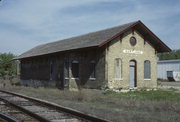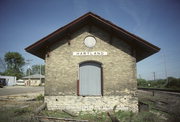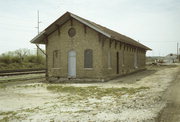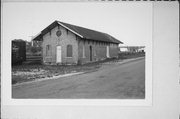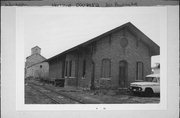| Additional Information: | A 'site file' exists for this property. It contains additional information such as correspondence, newspaper clippings, or historical information. It is a public record and may be viewed in person at the Wisconsin Historical Society, State Historic Preservation Office.
Another map code for this building is WK F 2/23, found on the DOT map.
Description:
The Chicago, Milwaukee, and St. Paul Railroad Depot is located at 301 Pawling Avenue in the Village of Hartland. Built in 1879, the depot is a one story gabled brick Italianate structure set on a stone foundation. A bullseye window appears in each gable end, and on the south facade, a bay ticket window. Brackets line the eaves. The passenger's waiting room, located on the east end, is paneled. An old iron "Fairbanks Standard" scale stands in the freight section. Although the depot is vacant and boarded up, and appears rundown, it is structurally sound. The Hartland Historical Society purchased the building in 1982 and plans to move in when funds permit.
Architectural/Engineering Significance:
The Railroad Depot has architectural significance as the only structure associated with the railroad extant in Hartland. The depot provides a fine example of the Italianate style applied to a functional use, and retains excellent integrity, both architecturally and in terms of its site. Hartland's depot bears a strong resemblance to the Chicago, Milwaukee and St. Paul Railroad Depot in Brodhead, built by the railroad in 1882. Hartland's depot was also undoubtedly built by the railroad. Both depots are late examples of the Italianate style, traditionally utilized by the railroad long after it had diminished in popularity.
Historical Background:
The Milwaukee and Watertown Railroad company was chartered on March 11, 1851. Reaching Hartland in 1854, the first depot was likely nothing more than a shanty. It was replaced by a wooden structure in 1869, which was subsequently struck by lightning and burned in 1879. The present brick depot was then built. It was a utilitarian structure that incorporated an agent's quarters, waiting area and freight room. [A]
Reflecting the number of prominent resorts in the area, the railroad decided to build impressive new depots between Pewaukee and Oconomowoc. Oconomowoc's depot was completed in 1896, and Hartland's followed.
There was some question about where the new depot would be placed. Local businessmen wanted the railroad to buy land between Cottonwood and Maple, build a new road, and put the depot there. Their argument soon became moot, since the railroad was unable to negotiate a price with Stephen Warren and Henry Van Buren, the owners. It was then decided to move the old depot about 600 feet west, retaining it exclusively for freight, and build an elaborate new depot on the site. [B].
The new depot fell victim to a 1916 conflagration. Thus the fifth and final depot was built in 1917. It was this concrete and stucco structure that served the railroad until 1969 when it was removed. [C, D]
At its highpoint in 1909, the railroad had sixty five trains passing through Hartland. Service began to dwindle significantly after the Second World War, however, as the automobile surpassed the train in popularity. Passenger service was terminated in the early 1970s when the Cannonball, the local communter train, was discontinued. Freight service continues today.
Historical Significance:
Since Hartland was never more than a passenger and freight stop along the mainline, the railroad's history is really manifested in the depot and its evolution. Because the current subject is the only one remaining of five depots built in Hartland, and considering what a vital transportation link the railrailroad provided for community businesses and agriculturists, it is judged historically significant. |
|---|
| Bibliographic References: | A. Hartland History Group, "Hartland: A Chronicle," (Hartland, WI, 1976), p. 8.
B. Hartland History Group, "Hartland: A Chronicle," 1838-1976. Hartland, WI, 1976.
C. No bibliographical reference was given.
D. No bibliographical reference was given.
E. "Hartland Lake Country Reporter." 9/26/1995.
Dousman Kettle Moraine Index 6/5/2003. |
|---|

